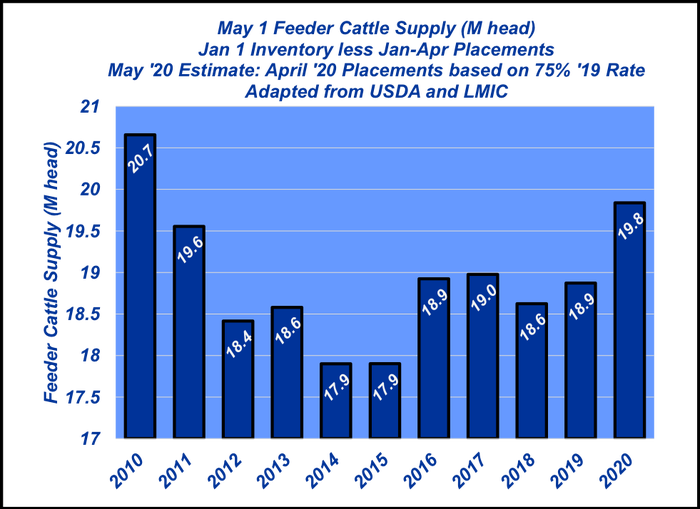According to May 1 feeder cattle inventory figures, large numbers of feeder cattle are outside feedyards. Value-added management and subsequent marketing is more important than ever.
April 30, 2020

During the past several weeks, this column has highlighted the dramatic effects COVID-19 has had on beef industry. As part of that series, Industry At A Glance recently featured the sharp slowdown in feeder cattle sales during the past six weeks or so.
That discussion noted that there will be some long-run ramifications because of the disruption. Most notably, “…those feeder cattle haven’t disappeared, they’re just being held at home. Eventually, that’ll likely be reckoned with a surge in feeder cattle placements in months to come…”
There are fewer cattle going to slaughter, that means reduced orders for feeder cattle placements to take their place. To that end, this week’s graph illustrates the reality of feeder cattle staying at home. The data represent the January 1 feeder cattle inventory outside of feedyards less placements during January through April. The net result being available feeder/stocker supply on May 1.
The year started with 26.45 million head – right in line with the last four years: the 2016 to 2019 average equals 26.32 million head. However, reduced placements as a result of COVID have dramatically changed the year-over-year comparison.
That is, the May 1 inventory in 2020 looks very different compared to the previous four years. This year’s total is over 1 million head bigger versus available supply between 2016 and 2019 (18.85 million head).

Once some sense of normalcy returns, it’ll be challenging for the industry to absorb those extra cattle in a seamless fashion. And meanwhile, the spring calf crop will also begin pressuring available supply as we transition to the fall marketing season.
Bottom line, bigger supply rules the day—there’ll be no shortage of feeder cattle going forward. Clearly, that’ll have a negative influence on price, not to mention the string of heavy losses in the feedlot sector. That said, value-added management and subsequent marketing is more important than ever.
Nevil Speer is based in Bowling Green, Ky. and serves as director of industry relations for Where Food Comes From (WFCF). The views and opinions expressed herein do not necessarily reflect those of WFCF or its shareholders. He can be reached at [email protected]. The opinions of the author are not necessarily those of beefmagazine.com or Farm Progress.
About the Author(s)
You May Also Like





